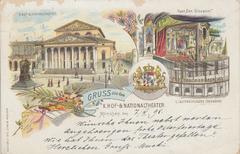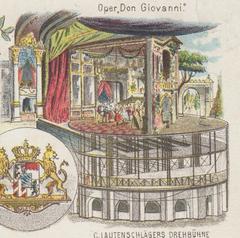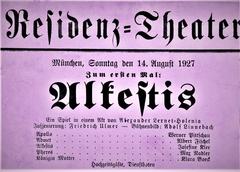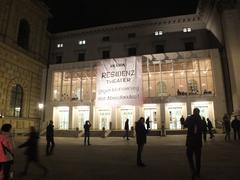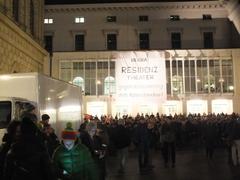
Residenz Theatre Munich: Complete Visitor Guide, History, Tickets, and Hours
Date: 14/06/2025
Introduction
The Residenz Theatre, or Residenztheater, stands as a cultural beacon in the heart of Munich, seamlessly merging centuries of Bavarian history, architectural brilliance, and the performing arts. Known both for its modern New Residence Theatre and the meticulously restored Cuvilliés Theatre, this complex offers visitors an immersive journey into the region’s artistic legacy. This guide provides comprehensive information for visitors—including historical context, architectural highlights, visiting hours, ticketing, accessibility, and practical tips—to ensure you make the most of your experience at one of Munich’s most treasured cultural destinations.
Table of Contents
- Introduction
- Historical Overview: Origins and Evolution
- Architectural Highlights
- World War II Impact and Restoration
- The Bavarian State Theatre: Role and Repertoire
- Visiting Information: Hours, Tickets, and Access
- Accessibility and Visitor Services
- Guided Tours and Special Events
- Nearby Attractions and Travel Tips
- Frequently Asked Questions (FAQ)
- Conclusion and Call to Action
- Sources
Historical Overview: Origins and Evolution
Founding and Early Years
The Residenz Theatre’s story began in the mid-18th century under Elector Maximilian III Joseph of Bavaria. After a fire destroyed the St. George’s Hall in the Munich Residenz, the Elector commissioned François de Cuvilliés to design a new court theatre. Completed in 1753, the original Residence Theatre—now known as the Cuvilliés Theatre—became a model of Rococo opulence (Cuvilliés Theatre - Wikipedia).
With its four tiers of gilded boxes, lavish ornamentation, and horseshoe-shaped auditorium, the theatre quickly became the centerpiece of Munich’s courtly and cultural life. Initially reserved for the royal family and court, it opened to the public in 1795, marking the theatre’s transformation into a civic institution.
Golden Age and Architectural Significance
The Cuvilliés Theatre is celebrated as one of the finest surviving examples of Rococo theatre architecture in Europe, renowned for its intricate red-and-gold interiors and exceptional acoustics. It hosted several world premieres, including Mozart’s Idomeneo (1781) and Carl Maria von Weber’s Abu Hassan (1811), cementing its reputation as a stage for both opera and drama (Cuvilliés Theatre - Wikipedia).
Architectural Highlights
The Cuvilliés Theatre
Designed by François de Cuvilliés the Elder and completed in 1753, the Cuvilliés Theatre boasts a horseshoe-shaped auditorium, four tiers of ornately decorated boxes, and an intimate, opulent atmosphere. Its exquisite Rococo ornamentation—allegorical figures, gilded carvings, and mythological motifs—reflects the artistic ambitions of the Bavarian court and the Wittelsbach dynasty (Absolute Munich).
The New Residence Theatre
After World War II, the destroyed original was replaced by the Neue Residenztheater (New Residence Theatre), completed in 1951 by architect Karl Hocheder. The new theatre, renovated by Alexander von Branca in the late 1980s, features modernist lines, an airy foyer with the “Silver Cloud” light sculpture, and the “Nachthimmel” (“Night Sky”) ceiling painting by Fred Thieler. Its 881-seat auditorium is celebrated for excellent sightlines and acoustics, offering an inviting space for both grand-scale and intimate performances (Residence Theatre - Wikipedia; Munich Travel).
World War II Impact and Restoration
The original Residence Theatre suffered severe damage during Allied bombing in World War II. In a timely act of preservation, the theatre’s carved wooden boxes were dismantled and safely stored. This allowed for their reassembly in the Residenz Palace after the war, leading to the reopening of the Cuvilliés Theatre in 1958. Today, it stands as a testament to Munich’s resilience and dedication to cultural heritage (Cuvilliés Theatre - Wikipedia).
The Bavarian State Theatre: Role and Repertoire
The Residenz Theatre is home to the Bavarian State Theatre (Bayerisches Staatsschauspiel), one of the largest and most influential spoken theatre companies in the German-speaking world. The theatre’s repertoire spans classical masterpieces, world premieres, and innovative contemporary works, with a longstanding tradition of fostering artistic excellence and experimentation (Munich Travel - Theatre Premieres).
Visiting Information: Hours, Tickets, and Access
Opening Hours
- Residenztheater (New Residence Theatre):
- Box office: Monday–Saturday, 10:00 AM – 6:00 PM (extended on performance days)
- Performances: Evenings; exact times vary by production
- Cuvilliés Theatre:
- April–October: Tuesday–Sunday, 10:00 AM – 5:00 PM
- November–March: Tuesday–Sunday, 10:00 AM – 4:00 PM
- Closed Mondays and public holidays (Residenz München)
Ticket Information
- Residenztheater (Performances): €10–€70, depending on event and seating
- Cuvilliés Theatre (Museum Visits):
- Adults: €10
- Reduced (students, seniors): €7
- Children under 18: Free
- Family and combination tickets available
- Where to Buy: Online (official websites), at the box office, or at the Munich Residence’s main cash desk. Advance booking is recommended (Residenztheater Schedule).
Location and Getting There
- Address: Max-Joseph-Platz 1 / Residenzstraße 1, 80333 Munich, Germany
- Public Transport: U-Bahn (Odeonsplatz, lines U3/U4), tram lines 19/27, bus lines 52/58. Parking is limited; public transport is advised (Munich Travel).
Accessibility and Visitor Services
- Wheelchair-accessible entrances and seating in both the New Residence Theatre and Cuvilliés Theatre
- Accessible restrooms within the complex
- Audio guides and printed materials in multiple languages
- Assistance for visitors with disabilities can be arranged on request (Bayerische Schlösserverwaltung).
Guided Tours and Special Events
- Guided Tours: Available for both theatres, providing insights into the history, architecture, and cultural significance. Multilingual audio guides are also offered (Munich Travel).
- Special Events: Theatres host regular performances, concerts, and festivals. For example, a Festive Concert is scheduled on June 29, 2025 (Classictic).
Nearby Attractions and Travel Tips
- Munich Residenz Museum: Explore royal apartments, the Treasury, and the Court Church of All Saints.
- Hofgarten: A tranquil Renaissance garden adjacent to the complex.
- Bavarian State Opera, Nationaltheater, and Marienplatz: All within walking distance (Munich Travel).
- Travel Tips:
- Arrive early, especially during peak tourist seasons.
- Combine your theatre visit with other attractions in the area.
- Dress appropriately for theatre performances.
- Check official sites for last-minute changes or closures.
Frequently Asked Questions (FAQ)
Q: What are the Residenz Theatre visiting hours?
A: Box office: 10:00 AM – 6:00 PM (Mon–Sat); performances in the evenings. Cuvilliés Theatre: Tues–Sun, 10:00 AM – 5:00 PM (Apr–Oct), 10:00 AM – 4:00 PM (Nov–Mar); closed Mondays/public holidays.
Q: How do I purchase tickets?
A: Online via official websites, at the theatre box office, or at the Munich Residence’s main desk.
Q: Is the theatre wheelchair accessible?
A: Yes, including accessible entrances and restrooms.
Q: Are guided tours available?
A: Yes, both group and self-guided audio tours are offered.
Q: Can I take photographs?
A: Personal photography is permitted (no flash/tripods); photography is prohibited during performances.
Conclusion and Call to Action
The Residenz Theatre and Cuvilliés Theatre are essential stops for anyone interested in Munich’s history, architecture, and performing arts. From the opulent Rococo interiors to the modern, spacious auditorium, the complex offers a dynamic blend of the past and present. Plan your visit, book your tickets in advance, and consider attending a live performance to experience Munich’s cultural scene at its finest.
Download the Audiala app for up-to-date schedules, audio guides, and event notifications. For further travel inspiration, explore related articles on Munich’s top historical sites and performing arts venues, and follow us on social media for the latest updates.

